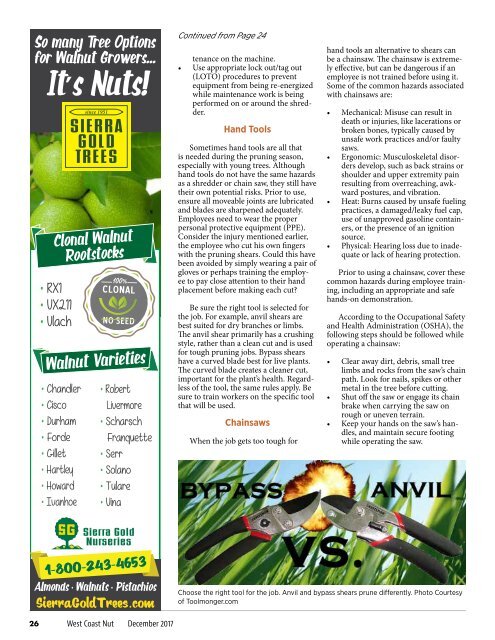WCN_Dec17WEB
Create successful ePaper yourself
Turn your PDF publications into a flip-book with our unique Google optimized e-Paper software.
Continued from Page 24<br />
tenance on the machine.<br />
• Use appropriate lock out/tag out<br />
(LOTO) procedures to prevent<br />
equipment from being re-energized<br />
while maintenance work is being<br />
performed on or around the shredder.<br />
Hand Tools<br />
Sometimes hand tools are all that<br />
is needed during the pruning season,<br />
especially with young trees. Although<br />
hand tools do not have the same hazards<br />
as a shredder or chain saw, they still have<br />
their own potential risks. Prior to use,<br />
ensure all moveable joints are lubricated<br />
and blades are sharpened adequately.<br />
Employees need to wear the proper<br />
personal protective equipment (PPE).<br />
Consider the injury mentioned earlier,<br />
the employee who cut his own fingers<br />
with the pruning shears. Could this have<br />
been avoided by simply wearing a pair of<br />
gloves or perhaps training the employee<br />
to pay close attention to their hand<br />
placement before making each cut?<br />
Be sure the right tool is selected for<br />
the job. For example, anvil shears are<br />
best suited for dry branches or limbs.<br />
The anvil shear primarily has a crushing<br />
style, rather than a clean cut and is used<br />
for tough pruning jobs. Bypass shears<br />
have a curved blade best for live plants.<br />
The curved blade creates a cleaner cut,<br />
important for the plant’s health. Regardless<br />
of the tool, the same rules apply. Be<br />
sure to train workers on the specific tool<br />
that will be used.<br />
Chainsaws<br />
When the job gets too tough for<br />
hand tools an alternative to shears can<br />
be a chainsaw. The chainsaw is extremely<br />
effective, but can be dangerous if an<br />
employee is not trained before using it.<br />
Some of the common hazards associated<br />
with chainsaws are:<br />
• Mechanical: Misuse can result in<br />
death or injuries, like lacerations or<br />
broken bones, typically caused by<br />
unsafe work practices and/or faulty<br />
saws.<br />
• Ergonomic: Musculoskeletal disorders<br />
develop, such as back strains or<br />
shoulder and upper extremity pain<br />
resulting from overreaching, awkward<br />
postures, and vibration.<br />
• Heat: Burns caused by unsafe fueling<br />
practices, a damaged/leaky fuel cap,<br />
use of unapproved gasoline containers,<br />
or the presence of an ignition<br />
source.<br />
• Physical: Hearing loss due to inadequate<br />
or lack of hearing protection.<br />
Prior to using a chainsaw, cover these<br />
common hazards during employee training,<br />
including an appropriate and safe<br />
hands-on demonstration.<br />
According to the Occupational Safety<br />
and Health Administration (OSHA), the<br />
following steps should be followed while<br />
operating a chainsaw:<br />
• Clear away dirt, debris, small tree<br />
limbs and rocks from the saw’s chain<br />
path. Look for nails, spikes or other<br />
metal in the tree before cutting.<br />
• Shut off the saw or engage its chain<br />
brake when carrying the saw on<br />
rough or uneven terrain.<br />
• Keep your hands on the saw’s handles,<br />
and maintain secure footing<br />
while operating the saw.<br />
Choose the right tool for the job. Anvil and bypass shears prune differently. Photo Courtesy<br />
of Toolmonger.com<br />
26 West Coast Nut December 2017


















